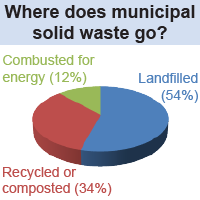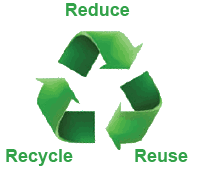|
 Technology makes our lives more productive and easier, and it also allows us to create enormous amounts of waste. Count how many trash bins go out on an average street every week. It takes energy, natural resources, and manufacturing labor to make a plastic cup, bottle, or cardboard box—all of which get thrown away. Where does it go after trash pickup? As much as 34% of solid waste gets either recycled or composted, about 12% gets burned, but 54%—more than half—is dumped into landfills. That is a lot of garbage that ends up in landfills!
Technology makes our lives more productive and easier, and it also allows us to create enormous amounts of waste. Count how many trash bins go out on an average street every week. It takes energy, natural resources, and manufacturing labor to make a plastic cup, bottle, or cardboard box—all of which get thrown away. Where does it go after trash pickup? As much as 34% of solid waste gets either recycled or composted, about 12% gets burned, but 54%—more than half—is dumped into landfills. That is a lot of garbage that ends up in landfills! 
|
 The mantra of “reduce, reuse, and recycle” is a reminder to all of us of how to do our part to reduce the waste that would otherwise end up in a landfill. Reduce waste by not using as much packaging. Reuse items such as plastic take-out containers instead of throwing them away. As much as possible, recycle items that cannot be reused. Plastic containers have a triangular recycling symbol with a number inside; those with appropriate numbers can be placed in special recycling bins rather than in the trash. Electronic devices should be taken to centers that reprocess the components. Used oil should be recycled at a service station. Household chemicals and fluorescent light bulbs should be disposed through your town’s special hazardous waste pickup days or at town recycling centers.
The mantra of “reduce, reuse, and recycle” is a reminder to all of us of how to do our part to reduce the waste that would otherwise end up in a landfill. Reduce waste by not using as much packaging. Reuse items such as plastic take-out containers instead of throwing them away. As much as possible, recycle items that cannot be reused. Plastic containers have a triangular recycling symbol with a number inside; those with appropriate numbers can be placed in special recycling bins rather than in the trash. Electronic devices should be taken to centers that reprocess the components. Used oil should be recycled at a service station. Household chemicals and fluorescent light bulbs should be disposed through your town’s special hazardous waste pickup days or at town recycling centers. 
|
Nearly 500 billion beverage cans are produced worldwide every year, most of which are made out of aluminum. Manufacturing aluminum from raw materials such as bauxite ore requires a great deal of energy, since the melting point of aluminum is 660°C (1,220°F). It takes approximately 800 kJ (800,000 J) of energy—enough to power a 100 W light bulb for more than two hours—to produce an aluminum can that has a mass of only 15 g. A recycled aluminum can, however, requires 95% less energy to manufacture. Recycling of aluminum is not just about conserving a natural resource; it’s also about reducing our use of energy. 
|
Look at the sheet of paper in your notebook or on the printed page of this textbook. It took around 100 kJ of energy to produce that single sheet of paper directly from wood. Recycling the paper, however, saves one-third of that energy. Reducing your use of paper, reusing paper when possible (such as using old sheets as scratch paper), and recycling all will reduce the energy required to create the paper we use every day. It will also mean that fewer trees need to be felled to provide the paper we need. 
|
In your classroom, do your part in the proper disposal and recycling of materials. - Reduce: Take only those materials you need to do your investigation,
- Reuse: Use materials more than once where possible,
- Recycle: Dispose of materials in the appropriate locations so that as much as possible can be recycled.


|
| |
|

